It started, as these things do, with a lot of promise. It was 1974 and a brand new comic book publishing company offered creators high pay rates to write and illustrate an entire new universe full of characters. Atlas-Seaboard offered forms of creator ownership, a venue for trying new things, and a mix of established, seasoned professionals, and hot newcomers.
The very existence of this firm challenged the big two in terms of retaining creators. If this new enterprise succeeded, Marvel and DC would have to either accept their losses or raise their own pay rates. Sure, going up against the big guys had been tried before, but this time it at least seemed different.
Marvel Comics founder Martin Goodman, who had sold Marvel a few years before, and his son Charles, started Seaboard Periodicals with the hope of rivaling Goodman’s old company. To do this, they followed the Marvel formula of the day: superhero comics, barbarian comics, and black and white magazines. They even adopted the name Atlas, familiar to Silver Age fans as the name Marvel published under after Timely and before Marvel Comics.
As editor-in-chief, they signed up Jeff Rovin, known to many comic fans for his time editing at Warren (and who has written the Tom Clancy’s Op Center series, much of it for a token thank you on the acknowledgement page).
As editor, the Goodmans hired Larry Lieber, a Marvel veteran dating back to when Marvel itself was called Atlas. Lieber, of course, is Stan Lee’s brother and remains known to comic fans today as the artist of The Amazing Spider-Man daily comic strip, which Lee writes.
The general look of the comic book covers, unlike the magazines, was also about as Marvel as one could get shy of using the Marvel logo. Creators including Steve Ditko, Wally Wood, Archie Goodwin, Howard Chaykin, Jack Sparling, Rich Buckler, and others made the move to Atlas.
“In the late Summer of 1974, the comics press eagerly anticipated the arrival of the upstart Atlas/Seaboard (a moniker settled on by comic book historians to distinguish it from the 1950s line of Martin Goodman, though officially it was Seaboard Periodicals, parent company of the new Atlas Comics),” wrote comics historian John B. Cooke in Comic Book Artist #16.
“Inside Comics #3 (Fall 1974) speculated, ‘Seaboard seems to be off on the right foot and, if their plans succeed, we may be in store for a real treat,” he wrote, noting further advance praise from Jim Steranko's Mediascene #11 (January-February 1975) and in The Comic Reader #109 (August 1974).
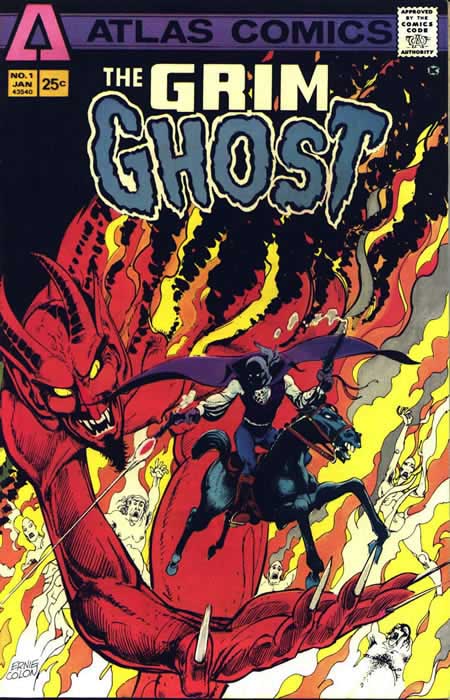
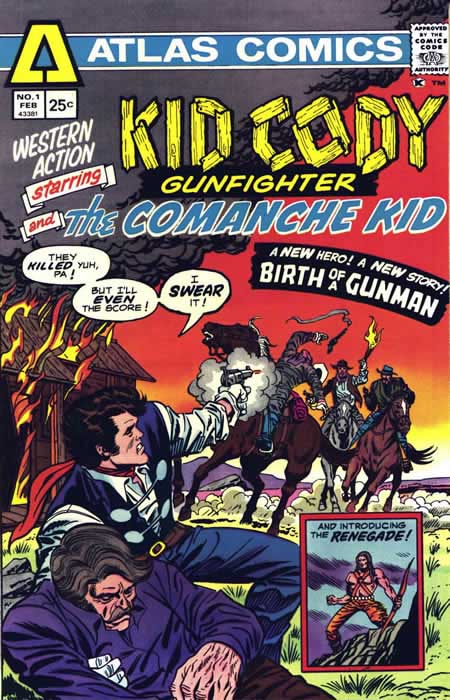
Original characters like Demon-Hunter (created and illustrated by Buckler) and The Scorpion (created, written, and illustrated by Chaykin) were intermingled with a Hulk knock-off (The Brute), a sort of negative image version of Spider-Man (The Destructor), and a couple of Marvel-esque barbarians (Iron Jaw and Wulf the Barbarian).
Several of the titles, though trite in concept, had a smattering of freshness due to the talent involved. The Destructor, for instance, featured the team of Archie Goodwin (writer), Steve Ditko (pencils), and Wally Wood (inks). The concept, young man headed down the wrong path until death of a loved one forces him to confront responsibility. Throw in a grave side vow of righting wrongs, and you get the idea. Still, in his pre-hero days The Destructor is actually an anti-Peter Parker of sorts. Not the most original of ideas, but with a team like this it’s hard to be that far wrong.
Unfortunately, though, many of the titles read as if the publisher (Charles Goodman, at least in title) said, “We need a Hulk book” or “We need a horror book.” The lack of originality didn’t help sales that were already hampered by limited newsstand space. Marvel and DC had increased their output and pushed Atlas off the shelves. There was no direct market for comic books yet, so the newsstand was life or death. In this case, it wasn’t life.
“What the Goodmans did go out of their way to do was to tackle Magazine Management and Marvel head-on. The bitterness they felt about Chip’s falling-out was clear not only in the similar nature of the Seaboard titles in production and on the drawing boards, but in the choice of Atlas as a name for the comics, Atlas having been a Marvel imprimatur during the 1950s,” Rovin wrote much later in the pages of The Comics Journal. “Unfortunately, anger is a lousy reason to start a publishing company; not only are bad calls made in an effort to be vindictive or to recapture lost glories, but the angry party tends to lose interest when the anger fades and the bills continue to mount. That was to prove a fundamental problem at Atlas Comics.”
In a profile several years ago in Comic Book Marketplace, Lieber recounted how he was on jury duty while awaiting the verdict on whether Atlas lived or died. The word came down, and that was that. The short-lived experiment was less than two years in duration with less than one full year of published product.
The promise of Atlas at the beginning was probably gone well before the end. Creators had, in fact, been bailing for several months (see sidebar). Chaykin left over a dispute which resulted in The Scorpion #3 having little, if anything, to do with The Scorpion #1-2. From one of their few sparkling gems of originality, the title immediately became a bad Daredevil/Spider-Man sort of coagulation.
Larry Hama, writer-artist on Wulf the Barbarian, had also already quit. Pay rates were headed down and the seemingly arbitrary nature of the editorial decision making accelerated the process. There was a fair amount of finger pointing at the time and that hasn’t changed in years since.
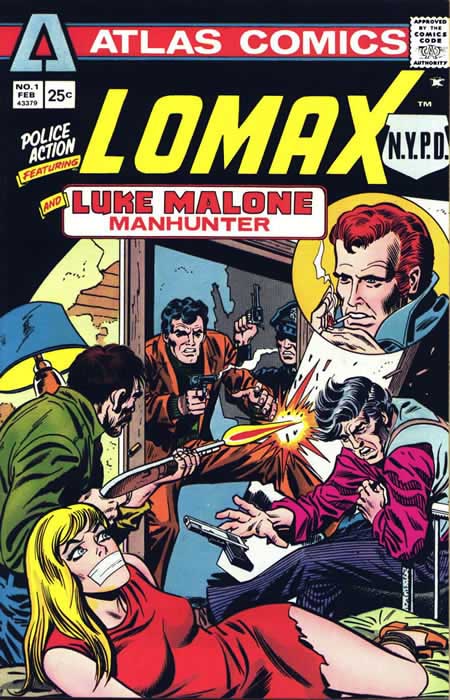
The legacy of the Atlas line is small, but in a way it is not insignificant. They were the first to challenge Marvel and DC in the ‘70s. The idea of offering a degree of creator ownership or control was still entirely foreign to the big two then, truly existing only in the undergrounds of the day.
Would Eclipse Comics or Pacific Comics have popped up when they did, or later First Comics if Atlas hadn’t taken the plunge? The creator rights movement practically guaranteed something would have happened sooner or later, but without Atlas there’s got be at least a small question of whether it would have happened the way it did.
Martin and Charles Goodman got out of comics for good. Jeff Rovin has worked in the comics field and other media. Larry Lieber has illustrated a very long run on The Amazing Spider-Man newspaper strip scripted by his brother, Stan Lee. The various creators employed by Atlas went many different directions. Some were never heard from in comics again. Some went on to become comics superstars.
Two of the characters also found employment with other publishers. Sure, it’s not the first time a character has been picked up. The modern era of DC, for example, encompasses characters created at Fawcett, Charlton, Quality, and elsewhere. The characters in question are Demon-Hunter and The Scorpion, and both of them landed at Marvel. Actually, Demon-Hunter landed in two places.
In his Atlas origin story (and only issue), Gideon Cross had renounced the demon cult which had granted him incredible powers and now stood opposed to them. Their goal was “Xenogenisis,” the rebirth of a demon race on earth. David Anthony Kraft (Comics Interview) wrote it and Rich Buckler plotted and illustrated it.
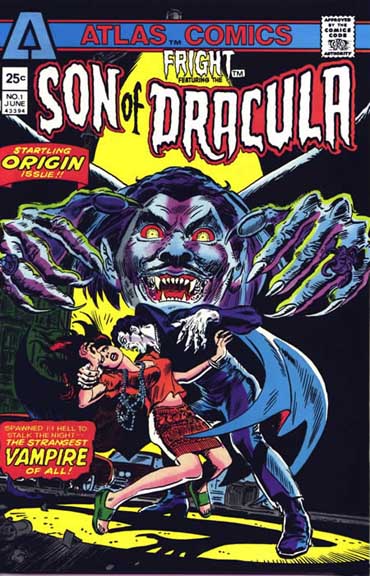

Meanwhile, over at Marvel, Buckler’s “Deathlok The Demolisher” series in Astonishing Tales had been canceled mid-story. The story was to be more or less wrapped up in Marvel Spotlight #33 (1977), although it would also carry into Marvel Two-in-One #27 before fading into the great land of permanently dangling storylines. Again with Kraft writing and Buckler illustrating, Deathlok returned ostensibly for the wrap-up story. Only it was easily as much the origin story for Devil-Slayer.
Devil-Slayer was Eric Simon Payne. He had renounced the demon cult which had granted him incredible powers and now stood opposed to them. Their goal, and stop me if you’ve heard this before, was “Xenogenisis,” the rebirth of a demon race on earth. His costume was blue with an orange cape where Demon-Hunter’s was red with a blue cape, but otherwise it’s the same guy.
Devil-Slayer went on to pop up in Kraft’s The Defenders #58-60 (1978) for a three-part story entitled, not surprisingly, “Xenogenisis.” He wasn’t done there. Well, Devil-Slayer was, as was Eric Simon Payne, but Gideon Cross wasn’t. Cross came back as Bloodwing, in the Buckler-published Galaxia Magazine (1981). This one didn’t get as far as mentioning Xenogenisis, but there was mention of a demonic “Crimson Brotherhood.” The character looked the same as his Marvel incarnation on the color cover (interiors were black and white), but the feel was a little more rough and tumble.
Since the early 1970s, Howard Chaykin seems to have been turning out intense characters with heavy doses of adventure, politics, sex and a generally cynical, rogue-ish behavior: Cody Starbuck, The Scorpion, Dominic Fortune, his version of The Shadow, American Flagg, and Power & Glory.
At Atlas, a falling-out over control of The Scorpion lead to Chaykin’s departure before the ship had sunk. He showed up at Marvel where he, with Len Wein providing a script, came up with Dominic Fortune. The color of the outfits may be slightly different, but the attitude and presence of the characters is unmistakably the same. The result was two stories, one written by Wein and one by Chaykin himself, that appeared in Marvel Preview #21 under the “Bizarre Adventures” banner.
The background stories were different enough. The Scorpion was set in New York and the character was somehow long-lived and of unspecified age. He was, though, a mercenary for hire with the same attitude and demeanor as Dominic Fortune, who instead lived just off the west coast, near Los Angeles, outside territorial waters, on a rather large gambling ship. Both were set in the late 1930s and had elements of the approaching World War II looming in the background.
Missing from Fortune was the undefined extended life scenario, but otherwise their similarities overwhelm the differences. Chaykin has explored the theme of extended life in other stories, too, most notably his four-issue DC Comics Shadow mini-series (1980).
Here's an alphabetical run-down of the titles in the Atlas line:
The Barbarians
This first (and only) issue of Atlas' third Sword & Sorcery title was to begin an ongoing anthology series featuring "not only established brawlers like Ironjaw and Wulf, but also new concepts in swashbuckling heroics..."
Published between Ironjaw #3 and #4, the lead feature united Ironjaw with his new biographer Gary Friedrich (who assumed scripting duties with #4) and set a new direction for the character's own series. The backup in this issue was the story of Andrax, an Olympic athelete from 1976 kidnapped by a mad scientist and put in suspended animation to awaken 2,000 years later in a desolate future.
Blazing Battle Tales
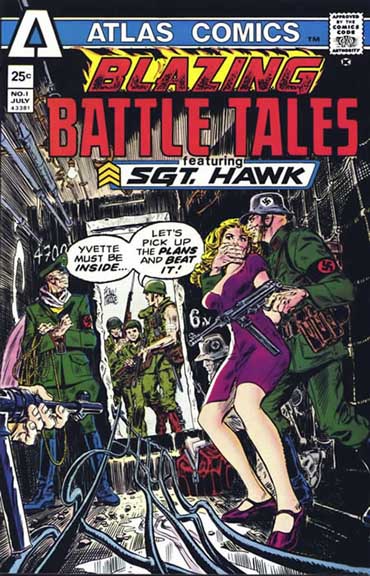
A one shot war comic featuring Sgt. Hawk and his killer Platoon. Set in WWII, we have potato mashers, damsels in distress, carnage and explosions...all typical of the genre. There's a couple of bondage panels and the omnipresent Nazi devils.
The one redeeming feature is a John Severin two-page salute to American hero Private William Swanson closing out this less than memorable book.
The Brute
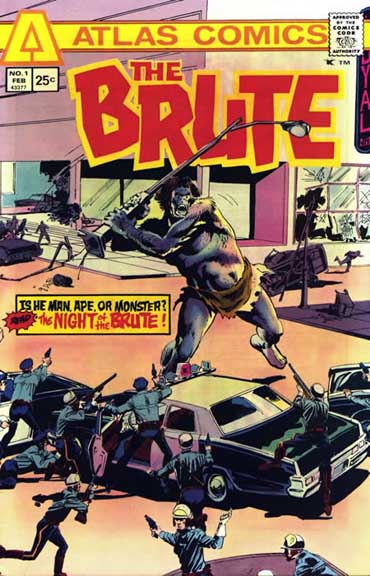
The Brute was a sub-human cave dweller frozen during the last Ice Age and thawed "in the Spring of 1975" from the heat produced by a nuclear power plant built near his subterranean tomb. Hungry and confused, the Brute kills two young boys exploring his cave. A female scientist is awarded custody by the court, but her plans of study are ruined when the father of the murdered boys is killed trying to exact vengeance.
From there, the series becomes a sub-human version of the Fugitive, with the woman scientist trying to save the Brute, even as police hunt him with orders to kill. The third and final issue foreshadowed a change in direction, with the Brute speaking his first words, and the introduction of a costumed nemesis, Doomstalker.
The Cougar

Stuntman Jeff Rand thrives on the danger of his chosen profession, he is known to his fellow stuntmen as The Cougar, due to his cat-like speed and agility. Issue #1 has him battling a vampire and pretty standard supernatural fare all around. Issue #2 shows us his origin and continues the tale with the obligatory werewolf saga. Battling throughout the issue his heretofore unknown werewolf brother, we never discover what happens to the crippled Cougar and his shattered spinal cord as the issue wraps up.
Demon-Hunter
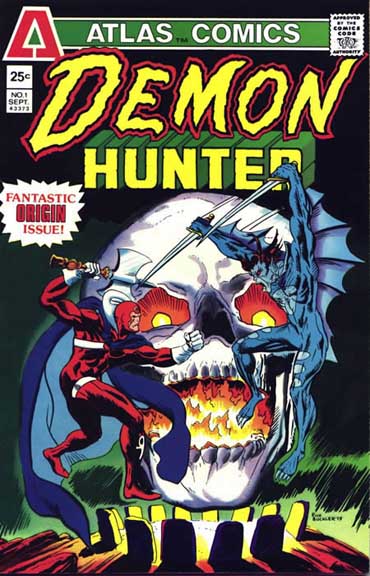
Created and plotted by Marvel veteran Rich Buckler, written by David Anthony Kraft (best known for his run on the Defenders), Demon Hunter was one of the most original titles published by Atlas-Seaboard (the character would later resurface as in two different incarnations.)
"What does a Demon Hunter do?" read the opening page, "Everything he can to prevent Xenogenesis...the rebirth of a demon race here on earth! His name? Gideon Cross. He is a telepath."
Empowered by a cult seeking to bring about Xenogenesis, Gideon Cross was empowered with a shadow cloak and new abilities to serve their bidding. He turned against them, however, and became a one-man force against their evil. Unlike Dr. Strange or Dr. Fate, Demon Hunter was fighting a specific war against a specific evil.
The Destructor
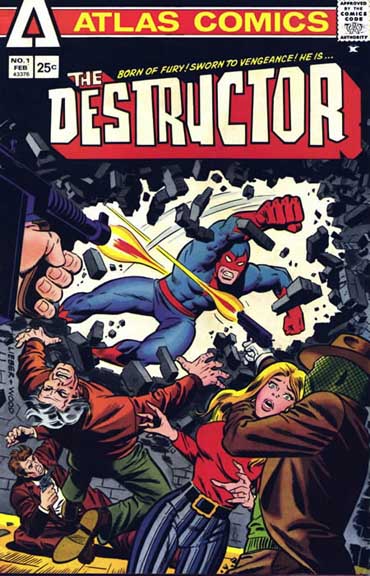
One of the longest-lived Atlas-Seaboard characters started with the amazing team of Archie Goodwin (writer), Steve Ditko (pencils), Wally Wood (inks) and Larry Lieber (editing).
Jay Hunter was a low life, young thug in training. His father was a noble scientist trying to come up with a formula to expand human senses, to create a super-hero. When Jay's crime lord boss marked him for death, both he and his father were mortally wounded. There was enough serum for one. His father gave it to him. He became the Destructor.
Almost an anti-Spider-Man, he was shunned by his high school crowd because he used to shake them down for money. Otherwise, this one stuck pretty close to the Spidey formula, down to the oath at the end of #1.
Goodwin stayed for three issues, with Gerry Conway writing the fourth. Ditko handled the art on all four with Wood inking the first two and Al Milgrom inking the fourth.
Fright
Featuring the Son of Dracula, this lone issue tells of the original Dracula's union with a female blood relative. Betrayed by Dracula following the birth of their son, the unnamed woman sends the baby to America with a foster mother, with instructions for his "protection". Furious, Dracula vows to one day reclaim his son.
Years later, in 1975, Columbia University professor Adam Lucard is horrified when his true nature reveals itself for the first time. Aware of his heritage, Lucard always takes nocturnal precautions passed down from his natural mother, but an intruder disturbs his rest and becomes his first victim.
The Grim Ghost

Recently hanged Revolutionary War highwayman Matthew Dunsinane is going to suffer the tortures of perdition, thanks to his new found buddy Satan, unless, of course, they can make a "deal". Lucifer wants Matthew to keep him supplied with souls for his domain since evil people deserve to die! Armed with a few parlor tricks supplied by Satan, the Grim Ghost is sent into the 20th century to harvest his crop of evil-doers. He rides mounted atop a jet black steed laughing like a demon from the darkest pits of hell only to battle evil in our time.
The Hands of the Dragon

Wu Teh was a twin raised by their grandfather in a mysterious Chinese monastery. Trained in the martial arts, the other twin, Ling, turned to evil. Wu Teh, also known as The Dragon, became a journalist and moved to America to seek out his evil brother, who worked for the Evil Dr. Nhu. Not just Dr. Nhu, Evil Dr. Nhu. The story was convoluted, but probably could have been straightened out if it had taken place over two issues. A second issue, though, this book would never have.
Ironjaw
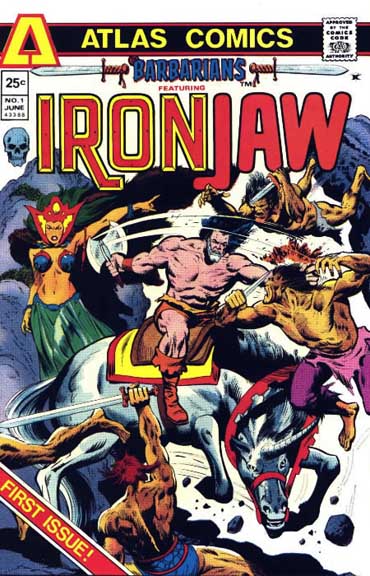
The first of the Atlas sword slinging characters, Ironjaw roams the world in earth's distant, post-apocalyptic future. He's a violent, amoral wanderer who lives for battle. Hired by rebels to help overthrow a tyrannical king, Ironjaw discovers his true heritage.
When he was an infant, his mother's lover killed Ironjaw's father, the true king, and ascended to the throne himself. With the complicity of the queen, the new king ordered the infant killed, since he would inherit the throne and depose the usurper upon reaching adulthood. A soft-hearted stablehand abandoned the infant on a snowy mountainside, rather than kill him.
After killing the tyrant-king, Ironjaw, identified by a distinctive birthmark as the true heir to the throne, is crowned king. Upon discovering to his dismay that "...a king cannot fight, or hunt, or steal or chase wenches...", Ironjaw chooses to slip away in the middle of the night, abandoning his new kingdom to resume his wanderer's ways.
After a personality-altering interlude in The Barbarians #1, Ironjaw returns in his fourth and final issue with the first part of his long awaited origin story; the tale of how the abandoned infant became the warrior.
Morlock 2001
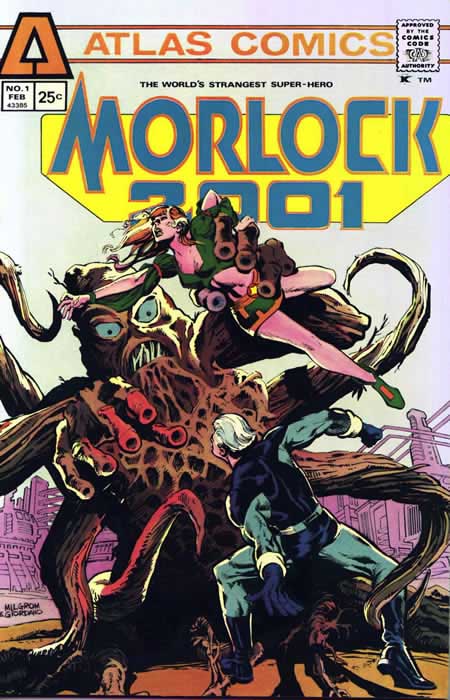
The year is 2001 A.D. A time when life as we know it has become hideously transformed. A rigid totalitarian regime holds the people in an iron grip, and humankind's greatest truths have been declared "inoperative". Professor Kroschell, the "mad botanical professor" has been conducting illegal botanical experimentations when he is gunned down by the jack-booted police. They confiscate a gigantic pod that holds a male human within its leaves. Outwardly appearing human yet structurally a plant, we are introduced to Morlock! When transformed into his plant-like form his mind is clouded with the bestial preoccupation for finding food.
Only to later find out that the mad scientist was planning to develop an army of Plant Men to overthrow the dictatorship, Morlock continues his fight against oppression in 2001. Beware the touch of Morlock! He'll turn everyone into fungus creatures. The saving grace is issue #3 which is drawn by Steve Ditko and inked by Berni Wrightson. Clearly one of the best issues in the entire Atlas comic book run.
The Phoenix

Near death, the sole survivor of the destruction of an orbiting space station is rescued by a group of aliens who observe the earth from a secret sub-Arctic base. The aliens have been monitoring human evolution, which they claim to have initiated millions of years ago through the deliberate mutation of prehistoric apes.
Incorporating some of the aliens' technology into his flight suit, the astronaut escapes from his captors. On the run, he stops to use his stolen powers to aid a disaster stricken Reykjavik, Iceland, thus alerting the aliens to his location. A battle ensues, and the alien installation is destroyed in an atomic explosion. Reykjavik is leveled by the shockwave.
On a rampage of revenge, the alien survivors set about the task of destroying all human life on earth, which they have now deemed a failed experiment. Beginning, of course, with New York City.
In issue #4 with new writer Gary Friedrich at the helm, the title changes to Phoenix, The Protector. Blaming himself for the alien attacks on Reykjavik and New York, and despairing of any hope for the future of humankind now that the aliens are on the warpath, Phoenix carves a tombstone for planet Earth and launches himself into space at full power, planning to burn himself up in the atmosphere.
Rescued by yet another group of aliens (The Protectors) Phoenix is given a choice. Revealing themselves to be the masters of the previous group of aliens, the Protectors offer Phoenix the opportunity to prevent the termination of all human life on Earth by proving they are "worthy" of life. Given a new costume, new identity, and new powers, Phoenix has become The Protector.
Planet of Vampires
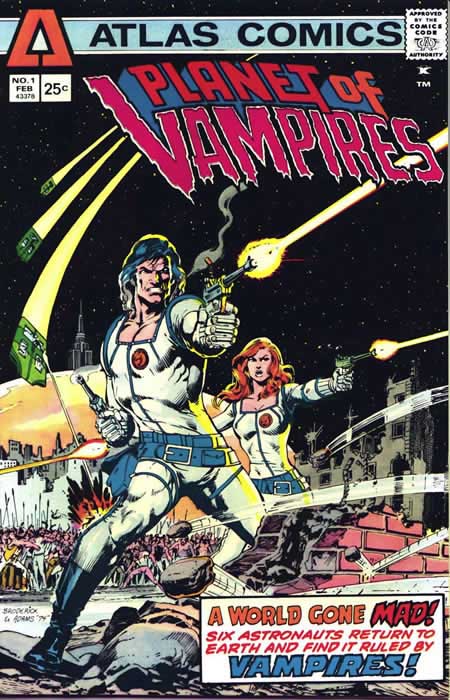
Playing on that era's popular post-apocalyptic sub-genre of science fiction, Planet of Vampires manages to incorporate elements of Planet of the Apes, Omega Man, and Buck Rogers into a very interesting concept.
Launched in 2010, a manned Mars mission returns to earth after a five-year journey. The six astronauts aboard are tense, arguing with each other, and they can't reach Mission Control. They're forced to make a water landing just outside of New York, a city they find in ruins.
Following a nuclear war, society has split in two. Those who live in a protective dome, and the savages outside it. The folks from the dome rescue the astronauts (well, five of them anyway) and present themselves as the saviors of humankind. Only the savages are actually the good guys, the "domies" have been mutated into vampires who prey on humans. Two great Pat Broderick-Neal Adams covers were followed by a Russ Heath cover.
Police Action
Big City cops are used to violence from petty heists to wholesale slaughter. But when one of their own ends up in pieces over a hundred foot area that's when NYPD's Sam Lomax gets called! Plenty of .38 Special gun play in these pages. Mike Ploog adds his Sam Spade-esque San Fransisco based gumshoe, Luke Malone, as the back-up feature. The artistic contrasts are striking. What we ended up with is a bi-coastal police drama that had seen its day before it was published!
Savage Combat Tales
This features Sgt. Ben Stryker and his Death Squad. Rescuing his band of war hardened combat happy commandos from certain death, Stryker assembles his group made up of unhappy U.S. Army prisoners Lee Shigeta, judo expert (and of Asian origin); Duke Ripley, circus acrobat; Turk Ankrum, behemoth pro wrestler' and Ice Marko, gangster (and of course, his last name ends in a vowel). They start out as jailbirds and end up as heroes. By issue #3, the convicts get pardoned for their heroic exploits and wonder how they'll spend the rest of the war in retirement. Unfortunately, these Archie Goodwin written tales end with #3.
The Scorpion

Probably the Atlas title with the most breakout potential was the Scorpion, written and illustrated by Howard Chaykin. At least the first two issues.
The Scorpion was a man presently called "Moro Frost", but who had many different identities over many different generations. Using themes he would continue to explore over the next 15 years, Chaykin created a pulp-type adventure hero set in the days just before World War II.
The only problem is, it seems, that Chaykin wasn't fast enough for the schedule assigned to him by editor-in-chief Jeff Rovin. One has only to compare the covers of the first two issues to see the results. The schedule problems are further evidenced by the veritable Who's Who of artists who helped Chaykin finish the second issue: Berni Wrightson, Michael Kaluta, and Walter Simonson among them.
The third issue has just about nothing to do with the first two. Chaykin quit over issues of control regarding his character when a Gabe Levy/Jim Craig story set 30 years later with the main character now a Daredevil-like costumed crime fighter. Only the logo remained.
Chaykin wasn't done with the character. He became Dominic Fortune at Marvel, where he pretty much promptly got lost in the shuffle. Chaykin, himself, though went to play a pivotal role in the independent comics boom of the early '80s with American Flagg and now works in Hollywood.
Tales of Evil
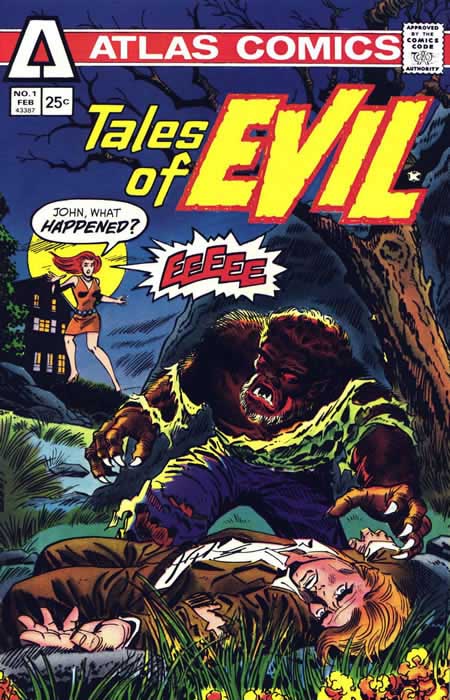
A horror anthology series with no regularly featured characters, Tales of Evil included stories of a demon conjuror, a werewolf, and a vampire in its inaugural issue. The second issue starred the Bog Beast, backed up with a ghost story and another werewolf story.
The final issue stars The Man-Monster, a conceited playboy mutated into an amphibious form by an unknown substance unearthed by an offshore oil rig. The Man-Monster, incidentally, battles a costumed villain named Hell-Blazer. The story concludes with the note "to be continued in the first exciting issue of the Man-Monster". Also appearing in this issue is a second tale of the Bog Beast.
Targitt
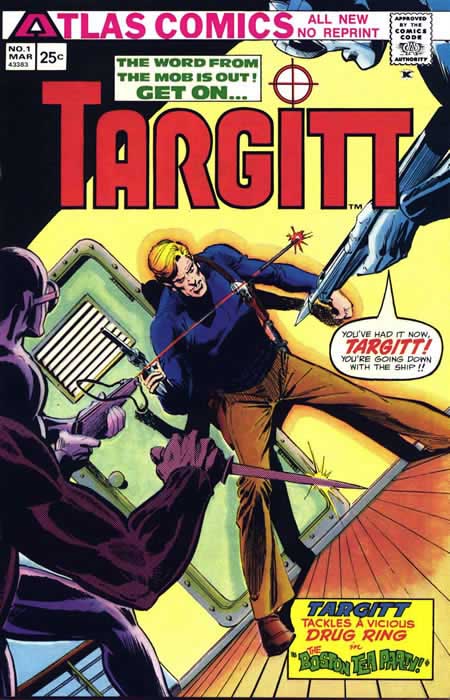
A candidate for the most neurotic title of the line. It starts like a typical guy-with-a-gun-gets-revenge-for-slain-family story complete with thugs, drugs, teenage killers, and the mob. Then the action gets, well, cartoony. Slapstick. He blows a guy's head off and the panel looks more like an Archie comic. A few pages later, Modesy Blaise would fit right in. And that's just the first issue. In the second issue, he gets a costume just like Daredevil's foe, Bullseye, and its a rocket sled downhill from there.
Tiger-Man
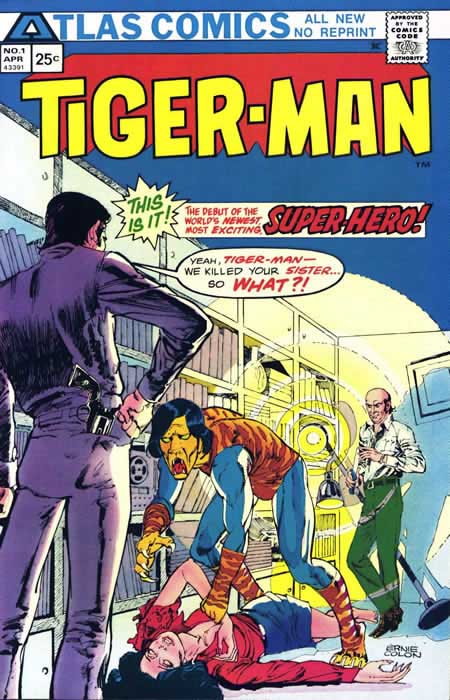
After injecting himself with an experimental serum derived from tiger chromosomes, a young doctor working in a clinic in Zambia acquires the strength, speed, and keen senses of a tiger. After his sister is murdered, Tiger-Man uses his enhanced abilities to track down and exact vengeance on her killers. Feeling unfulfilled after dispatching the murderers, Tiger-Man resolves to hunt down all criminals who prey on others.
Vicki
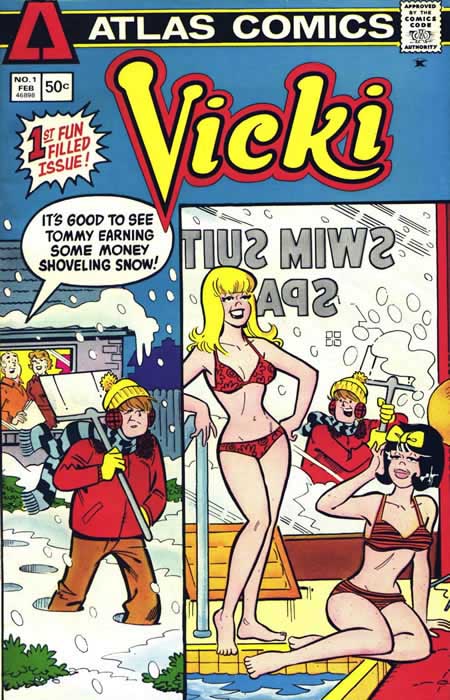
We have a teen blonde bombshell and her dark-haired female friend, Tommy the red-haired boyfriend and his dark-haired rival, and a large slow moving character named Tiny. Add them all up, drop them in Centerville, U.S.A. and you have Archie... er, Vicki..., Atlas' contribution to the teen scene.
Issue #1 is a 68 pager, but the oddball of the entire Atlas line is probably Vicki #2, the only Atlas square bound comic of all the line's issues! On top of it all, there is nothing even printed on the spine of this, likely the rarest comic Atlas ever produced. Once again we have cartoon teen hi-jinx set in the high school background of Anywhere, U.S.A. Enjoyable for just about any pony tailed youngster between the ages of 10 and 15.
Editorial note: The fantastic Atlas Archives website notes that Vicki is comprised of Tower Comics' Tippy Teen with many characters were slightly redrawn to reflect the more contemporary clothing and hair styles of the day.
Weird Suspense
The Dark Ages in Europe finds the soon to be burned at the stake Spider Princess of the Tarantula Cult placing a curse on the male descendants of her captor, Count Lycosa. They will be doomed to wander the countryside in quest of victims to appease their spider's lust! (whew)
Count Eugene Lycosa, the eleventh in line to bear the heinous curse, has vowed to use his tarantula powers for some practical purpose. It is the duty of the Avenging Arachnid to protect the helpless and prey on evil wherever it may flourish. Issue #2 finds the High Priestess back from the grave seeking vengeance against the Count Eugene Lycosa, only to again end up on the short end of the battle.
The last issue finds our spider-buddy fighting a turban-topped swami who has the power to control inanimate matter. Peter Parker has nothing to fear from this fly-headed webman.
Western Action
A "must have" for any serious western fan! Larry Lieber writes the "Kid Cody" story that is illustrated by Jonny Quest creator Doug Wildey! Better than average story and great art. The backup feature (by Steve Skeates and, incredibly, Jack Abel) features the Comanche Kid.
Wulf the Barbarian
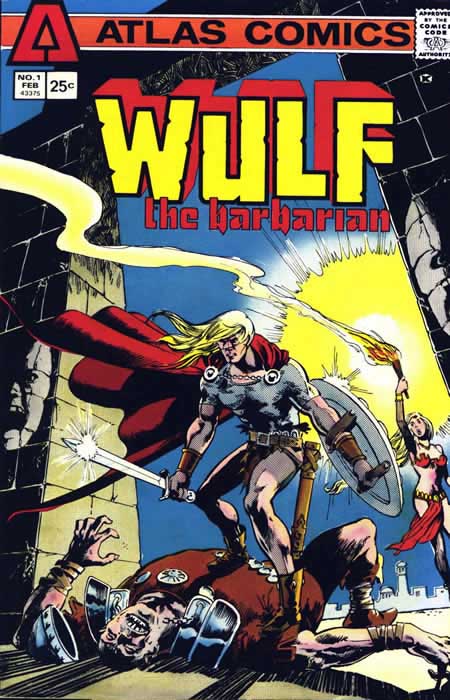
"...On a nameless world in a forgotten time..." there lived a man called Wulf. Orphaned 10 years ago when his parents, the king and queen, were slain in an ambush staged by trolls in the service of an evil sorcerer, Wulf has spent the last decade training for the day he would return to claim his birthright.
After his trainer/mentor is killed by the same troll who killed his mother 10 years earlier, Wulf avenges his mother's death, reclaims his father's sword from the slain troll, and begins his long awaited trip home. As Wulf rides homeward with the intent to raise an army to raid the evil sorcerer's lair and free his hereditary kingdom, he encounters many magic-induced obstacles conjured by his foe.
Devilina
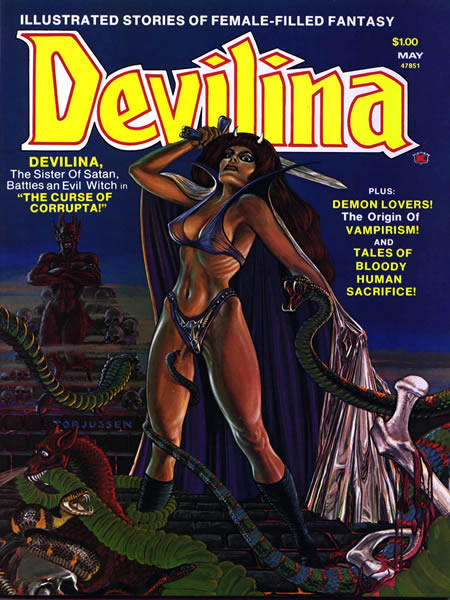
The only Atlas-Seaboard black and white magazine with a regularly featured character, Devilina is sort of a cross between Vampirella and Marvel's Santana. The sister of Satan, Devilina is transported through time, along with her mother, from the Biblical "time of the casting out" to modern day New England. There, under the watchful eye of her mother, the infant Devilina grows to womanhood in a mansion guarding "the secret entrance to Hell.
Shortly after arriving at college, Devilina is contacted by Satan, who invites her to join him in ruling Hell. She refuses and is allowed to return home. Years pass and Devilina pushes family concerns out of her mind as she pursues her studies. After her date to the graduation ball is killed in a fire triggered by Satan, she vows a war of vengeance on her brother. The rest of the book is an anthology of horror stories featuring women in the lead roles, including a tale of the reanimated mummy of Queen Nefertiri.
Gothic Romances
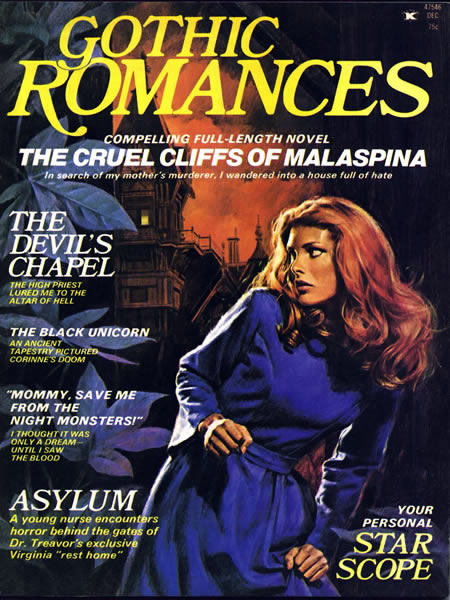
The real oddball of the Atlas-Seaboard line and probably the rarest they ever published. What red-blooded male teen would possibly buy this magazine in 1974? Check out the ads for teeth whitening, convertible nude bras, weight loss miracles, and wig sales! While certainly reminiscent of covers from DC's romance comics, and maybe even House of Mystery, the only redeeming virtue once you get by the overbearing text content is the spot artwork by the likes of Howard Chaykin, Ernie Colon, and even Neal Adams!
Movie Monsters
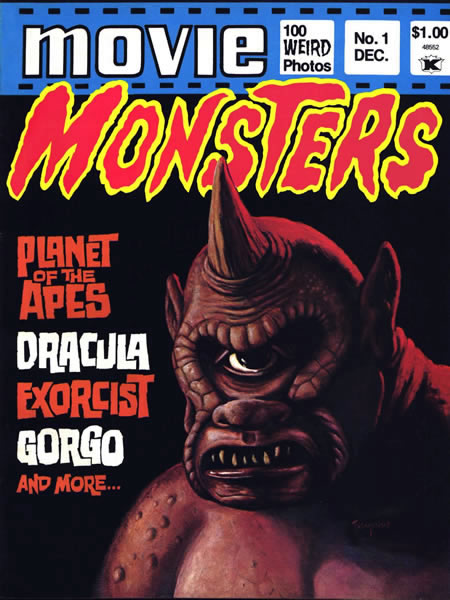
A large magazine format 8” X 10 3/4 " devoted to television and movie sci-fi and monsters. This black and white magazine utilizes movie stills and studio photos to illustrate this look at horror and space operas similar to the style of Famous Monsters of Filmland.
Thrilling Adventure Stories

These two issues, in particular the second, are worth the hunt it will take to find them. The first features a Tiger-Man story, a prequel to the series, and several other stories which would have been at home in any Warren title of the time. The first issue includes a beautiful Frank Thorne-illustrated version of "Lawrence of Arabia" and a really tacky, Warren-looking article on the films of Alistair Maclean.
The second issue is probably one of the all-time gems of black and white publishing. Starting with the Neal Adams cover, obscured with vapid copy, the issue contains an Archie Goodwin/Walter Simonson samurai story, circa their Manhunter collaboration, and additional pieces by Jack Sparling, Russ Heath, John Severin, and Alex Toth! It also includes a Warren-like article on the Towering Inferno.
Weird Tales of the Macabre
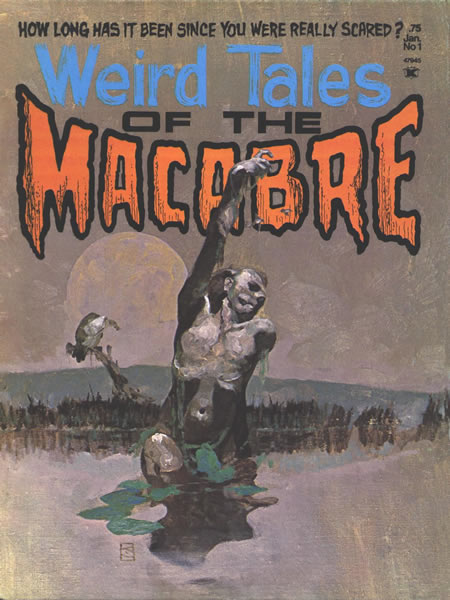
With covers by Jeff Jones and Boris Vallejo, respectively, the two issues of this series would have fit right in with the horror material being produced by Warren or Marvel at the time. Some beautiful work from artists including Pat Boyette, Ernie Colon, Leo Duranona, and John Severin. Bog Beast, seen in Tales of Evil, also appears in #2.

